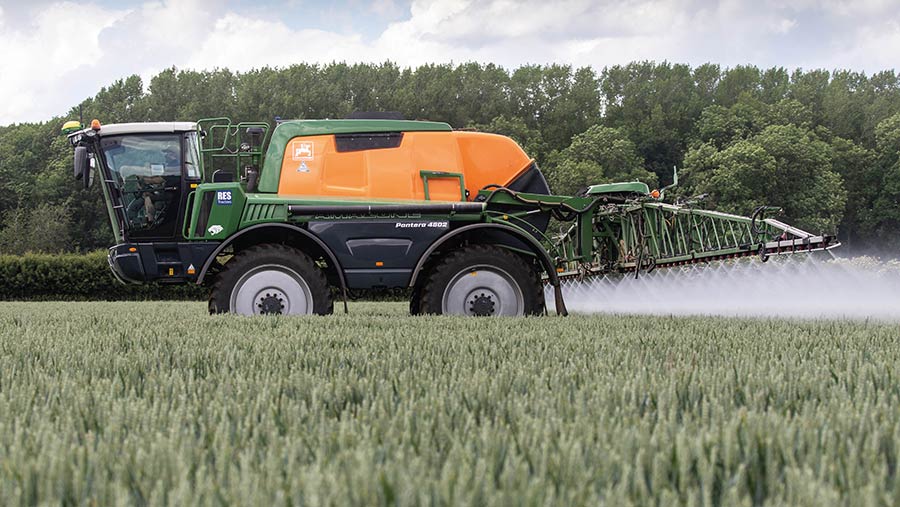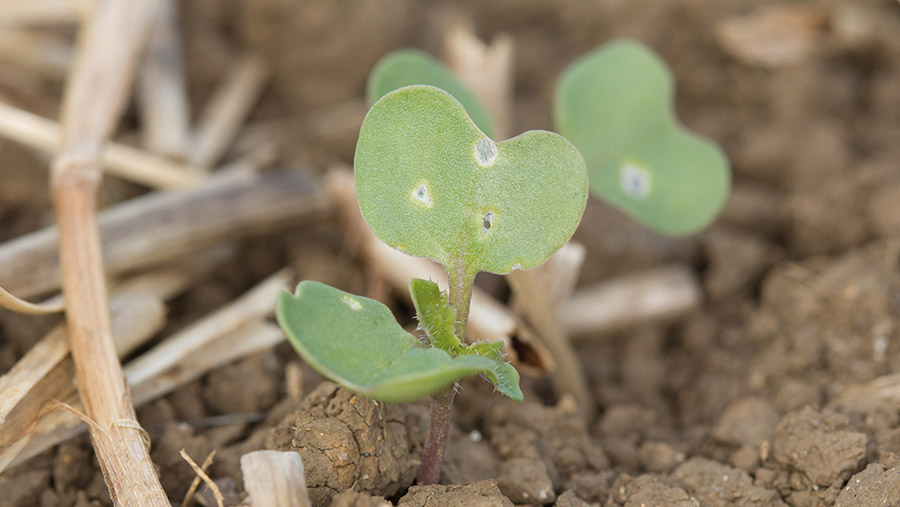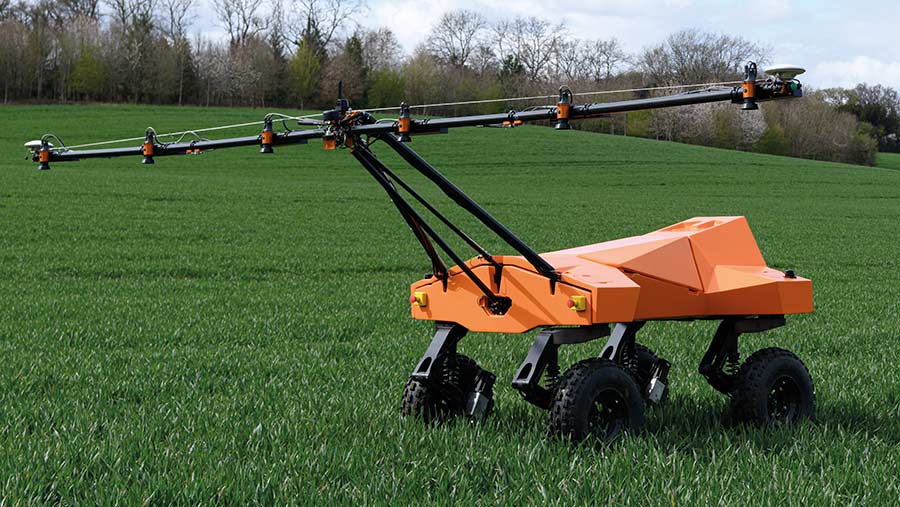3 technologies address arable farming’s biggest challenges
 © Tim Scrivener
© Tim Scrivener Innovative new technology hold the potential to combat some of the biggest agronomic challenges arable farmers face in yield stagnation, blackgrass control and cabbage stem flea beetle attack.
Farmers Weekly takes a look at some of these technologies showcased by start-up companies at AgriTechE’s annual Reap conference.
See also: How Kent grower plans to farm with no synthetic N fertiliser
Yield stagnation
It’s not often a product promises double digit percent increases in yield, but initial independent field trials suggest a novel biostimulant can increase winter wheat yields by up to 20% in the UK.
The biostimulant product being developed by start-up SugaROx, a joint-venture spin-out from Rothamsted Research and Oxford University, is based on a natural plant molecule, trehalose-6-phosphate (T6P).
T6P acts as a sugar signalling compound, explains Cara Griffiths, chief technology officer and co-inventor of the SugaROx technology.
“It directs how plants use their sucrose energy resources, by interacting with an enzyme pathway.
“With our product we are turning on the feast mode within the plant.
“That means by applying our products at the target growth stage we can turn on a lot of processes that are involved in carbohydrate storage, which could be good for yield improvement or drought resilience, for example.”
The first applications for the product, which is a modified pre-cursor of T6P to enable passive uptake into the plant, will be in wheat.
Other cereals, such as maize, barley, sorghum and millet, will also be targeted in future.
Initial research trials in winter wheat demonstrated a yield increase of about 20% from a single application of 1 litre/ha around grain fill.
Further independent trials have confirmed similar yield improvements in commercially grown winter wheat in the UK, Ms Griffiths says.
Another four independent trials are scheduled in the UK, Canada, Germany and USA for next year.
“Based on a more conservative estimate of 15% yield increase, that would mean a 24% increase in gross margin for farmers, and an 11% decrease in carbon dioxide equivalent per loaf of bread because we’re producing a more productive crop.”
Biostimulants in Europe are registered under a new EU Fertilising Products Regulation (FPR), which covers efficacy claims, while Registration, Evaluation, Authorisation and Restriction of Chemicals (Reach) legislation addresses safety requirements.
However, it is not clear at present how the UK government will register biostimulants, Ms Griffiths says.
“But based on an FPR framework, we expect full registration for a product to be on the market to take about three years,” she says.
Low-cost weeding
Tackling difficult grassweeds, including blackgrass, remains a key challenge for many growers. Start-up company Arwac’s solution is a battery operated, lightweight autonomous mechanical hoe.
The firm has received two Innovate UK grants to develop an autonomous robotic weeder in arable crops (Arwac), in conjunction with the University of Lincoln.
Initial research has found 25cm is the optimal row spacing for the hoe to work between. It will have row-following technology built in, explains Arwac managing director Nick Webster.
“We accept there will be blackgrass within the row, but we’re pretty certain we can achieve an 80% kill which is enough to give the crop a chance to be successful.
“Our calculations suggest we can make several passes through a crop in a season at less than the cost of treating blackgrass with herbicides using a sprayer.”
He says the optimum size for a machine that can carry four batteries which can be changed in the field is 1-2m wide.
“We’re working towards 12-hour shifts, where one man in a 4×4 can change the batteries and taken them away for recharging.
“We have doubts about the practicalities of any larger machine. Larger batteries will take longer to charge up and time is precious.”
The aim is for the machine to cover around 20ha in a 24-hour shift, and with swarm technology several machines can work together on a large area.
Blackgrass or weed areas can be mapped either by the farmer or by drone and used to create a hoeing map.
Confining hoeing to specific areas where needed will save energy and increase field work rates, Mr Webster says.
In addition, the team is aiming to design a hoe that moves as little soil as possible, again to reduce the power required for the operation and increasing range.
A base model is likely to record the path of the drill when seeding to guide the robot between the rows for the rest of the season.
More sophisticated machines could also include weed identification and additional row-following technology to improve precision hoeing, albeit still between rows.

© Tim Scrivener
Flea beetle solution?
A lucky meeting between two quite different companies working in Niab’s Innovation hub might provide a new solution to the oilseed rape grower’s biggest nemesis: cabbage stem flea beetle.
Cambond produces a plant-based resin from waste material from brewing, while Agrigrub takes around 10,000t/year of citrus waste from supermarket supplier AM Fresh.
By feeding it to black soldier fly larvae transforms it into protein-based food for exotic pets and fish, explains Gareth Roberts, co-founder of Wasware.
“As the bugs grow they shed their skins, creating their own waste stream called frass. Research suggests that if you spread frass on the ground as a powdery substance, it repels other bugs. It’s a bit like an animal marking its territory.”
Frass is also a valuable nutrient source for plants, he says.
Those two properties potentially make frass an interesting product for use in oilseed rape and other crops.
A conversation between the two companies and Niab’s Lydia Smith at the Royal Norfolk Show innovation hub hosted by AgriTechE culminated in the idea to use Cambon’s resin to stick frass to seeds as a treatment.
An Innovate-UK grant-supported laboratory trial by Niab with the Frasscoat product to test feasibility showed a positive response for both germination and plant growth rates, co-founder Xiaobin Zhao says.
A mixture of field and laboratory-based follow up trials with Niab, John Innes Centre and Rothamsted Research have shown a 20% improvement in seed germination and faster seedling growth.
There is also evidence of pest resistance, including against both cabbage stem flea beetle and slugs, although the effects have been mixed, Mr Zhao says.
“We’re hoping to run more field trials next year to investigate this further.”
With legislation banning intentionally applied microplastic film coatings in seed treatments expected to become effective in Europe around 2027, Cambond’s bioresin may also have a role to play in next generation biodegradable conventional seed treatments, he adds.
Small Robot Company launches new version of scanning unit

© Small Robot Company
The monitoring robot aims to optimise farmers’ existing sprayer equipment to reduce costs and inputs, by treating only the problem areas.
Field trials in 2021/22 suggested it could help cut herbicide applications by 77% and fertiliser by an estimated 15%.
Tom’s capabilities include precisely geolocated per plant data, precise plant counts, and high-resolution plant images, the firm claims, with the capability of seeing individual water droplets on leaves and early signs of disease outbreaks.
“Small lightweight robots protect the soil structure,” says Sam Watson-Jones, co-founder of SRC.
“This enables targeted applications of small amounts of treatment, reducing cost and protecting yields.
“Our business model makes the service accessible to farmers with as little as 20ha, without a costly machinery outlay.”

